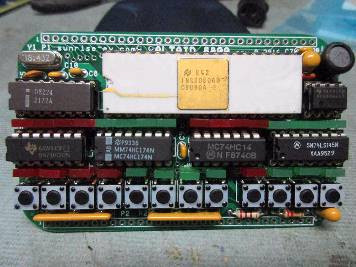It’s safe to say that the Altair 8800 is one of the most iconic, and important, computers ever created. The kit-built machine is widely regarded as the first commercially successful personal computer, and as such, intact specimens are bona fide historical artifacts when and if they ever come up on the second-hand market. Accordingly there’s a cottage industry out there dedicated to making affordable replicas, which more often than not, leverage modern hardware to emulate the original hardware.
But that’s not what the Altaid 8800 is. For one thing, it looks nothing like the original Altair. More to the point however, it’s not using modern components to emulate an Intel 8080 computer…it actually is an Intel 8080 computer — complete with fully functional front panel for manually entering in programs. It just happens to be small enough to fit into an Altoids tin, hence the name.
 Creator [Lee Hart] didn’t just stop at building a miniature 8080 machine, either. He’s also gone through the trouble of producing a sixteen page faux-vintage magazine to describe the project and its operation. Normally we’d call such a document a “manual”, but somehow in this case that seems to downplay the incredible effort and attention to detail that went into it.
Creator [Lee Hart] didn’t just stop at building a miniature 8080 machine, either. He’s also gone through the trouble of producing a sixteen page faux-vintage magazine to describe the project and its operation. Normally we’d call such a document a “manual”, but somehow in this case that seems to downplay the incredible effort and attention to detail that went into it.
Schematics and firmware are available should you wish to build your own version of the Altaid 8800, but we think the prices for the bare PCBs and complete kits that [Lee] is offering are more than fair for what you get. In fact, if you’ve always wanted to play around with front panel programming and the associated blinkenlights, this might be one of the most affordable options available. Though to be clear, you can also hook the Altaid up to your computer with a USB-to-serial cable if you’re not up to punching in programs on those tiny buttons.
You might think this is one of the most creative and unique retrocomputing projects we’ve ever seen, and you’d be right…if it wasn’t for [Lee]’s own Z80 Membership Card. In some ways the precursor to the Altaid 8800, this diminutive triumph also fits in an Altoids tin and features its own era appropriate magazine-style documentation. We’re detecting something of a theme with these projects…but we certainly aren’t complaining.



















